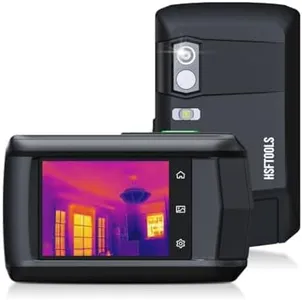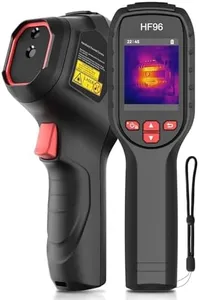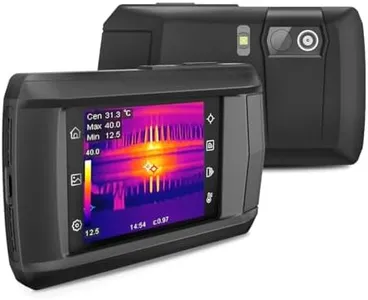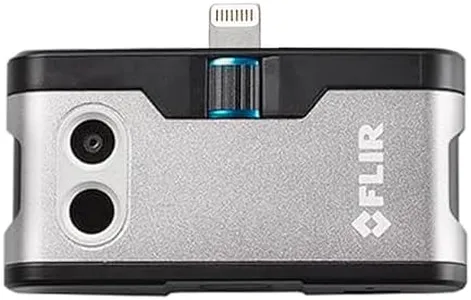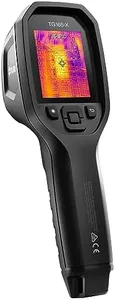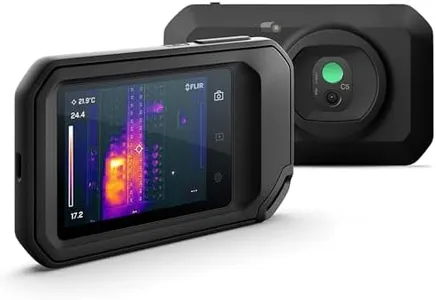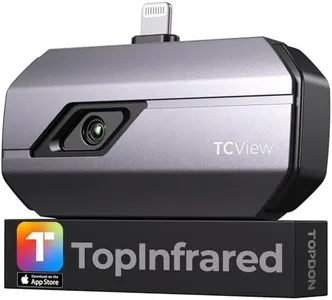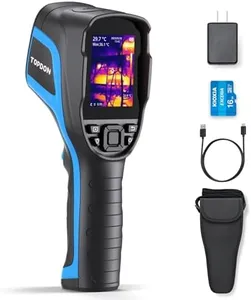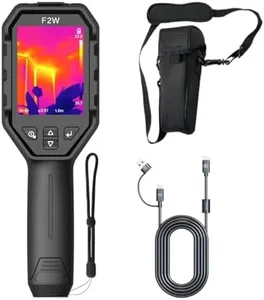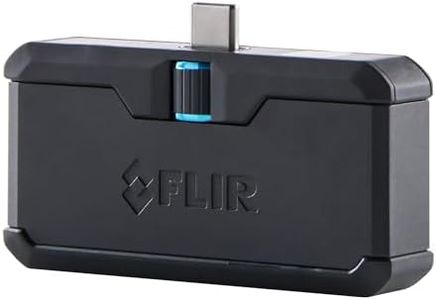10 Best Cheap Thermal Imaging Camera 2025 in the United States
Our technology thoroughly searches through the online shopping world, reviewing hundreds of sites. We then process and analyze this information, updating in real-time to bring you the latest top-rated products. This way, you always get the best and most current options available.

Our Top Picks
Winner
HSFTOOLS HF96 Thermal Camera, Super Resolution 240 x 240, Thermal Imaging Camera with Laser Pointer, 96 x 96 IR Resolution, 25 HZ Infrared Camera,-4°F to 1022°F, 50°FOV, 8h Battery Life Thermal Imager
Most important from
377 reviews
The HSFTOOLS HF96 Thermal Camera is an affordable option that offers notable features for thermal imaging. It boasts a 96x96 IR resolution, which can be enhanced to 240x240 using live super resolution technology, providing clear thermal images. The device has a temperature range from -4°F to 1022°F and a thermal sensitivity of less than 50mk, making it suitable for detecting small temperature differences. Its 25Hz frame rate ensures smooth imaging during inspections, and the 50° field of view allows for wide area coverage. The built-in laser pointer and seven color palettes enhance usability in various inspection scenarios.
The camera offers up to 8 hours of battery life and can store around 30,000 thermal images, which is convenient for prolonged use. It is also durable, featuring an IP54 protection rating and surviving drops from 6.6 feet, making it suitable for harsh environments. Additionally, the USB Cast Screen function allows for live sharing of the screen to a computer, aiding detailed inspections.
However, the image resolution, even with enhancement, may not match more expensive models, and the device's size might be cumbersome for prolonged handheld use. This thermal camera is a solid choice for users needing an affordable, durable, and reasonably accurate thermal imaging solution, especially for industrial or scientific applications.
Most important from
377 reviews
HP96 Thermal Imaging Camera, Super Resolution 240 x 240 Thermal Camera with Visual Camera, 96 x 96 IR Resolution, 3.5" Touch Screen, 25 Hz, Video and Audio Recording, 50° FOV, -4°F to 662°F
Most important from
309 reviews
The HP96 Thermal Imaging Camera stands out with its impressive live super resolution feature, enhancing the thermal image clarity from 96x96 to 240x240, making it suitable for detailed inspections. The dual cameras, including a 96x96 IR camera and a 640x480 visual camera, offer five image modes and eight color palettes for versatile use in different scenarios. This camera is easy to operate, thanks to its 3.5-inch touchscreen with a user-friendly interface, making it accessible even for less tech-savvy users.
The built-in eMMC storage and microphones support live video and audio recording, while the LED flashlight aids in low-light conditions. The 50-degree field of view provides broad coverage, and the device tracks maximum, minimum, and center temperatures for quick anomaly recognition. Additionally, its advanced VOx detector ensures accurate temperature readings with a discrepancy within ±2%, and the adjustable emissivity settings enhance accuracy across various materials. Durability is a strong point, with the camera featuring a 6.6ft drop test rating and IP54 protection, allowing it to withstand harsh environments.
The built-in rechargeable battery offers up to 4 hours of continuous use, which is decent but might require frequent recharging for longer tasks. The storage capacity of approximately 30,000 images and 20 hours of video is sufficient for most users. Its compact design and lightweight build make it portable and easy to handle. This camera is a solid choice for those seeking a budget-friendly thermal imaging solution with reliable performance, although the battery life might be a limitation for extended use.
Most important from
309 reviews
FLIR ONE Gen 3 - Thermal Imaging Camera for iOS Smartphones (iPhone w/Lightning Port Only. iPhone 14 and Older)
The FLIR ONE Gen 3 thermal imaging camera is a compact and convenient option for iPhone users looking to add thermal imaging capabilities to their device. It directly connects to iPhones with a Lightning port, making it easy to use on the go. With a thermal resolution of 80x60 and a visual resolution of 1440x1080, it provides decent image clarity for basic tasks like detecting heat loss in homes, identifying electrical issues, or inspecting mechanical equipment.
A notable strength of this camera is its accuracy in measuring temperature within ±3°C, which is sufficient for most DIY and casual applications. The ability to upload and share images via FLIR Ignite Cloud is also a big plus for users who want to organize and access their thermal images easily.
On the downside, the thermal resolution may not meet the needs of professional users requiring higher precision and detail in thermal imaging. The temperature range is somewhat limited, operating effectively between 5°C to 120°C, which could be restrictive for more specialized applications. Additionally, while the camera is designed to endure job site conditions, it still requires careful handling to avoid damage, especially considering that it's an accessory rather than a standalone device. Battery life is generally good, but the dependency on the phone’s battery for operation can be a drawback during extended use. Furthermore, this product is designed specifically for iOS devices, meaning Android users need to look elsewhere.
The FLIR ONE Gen 3 is a solid choice for casual users and DIY enthusiasts interested in thermal imaging at an affordable price. However, for professionals or those needing more advanced features, this might not be the best fit.
